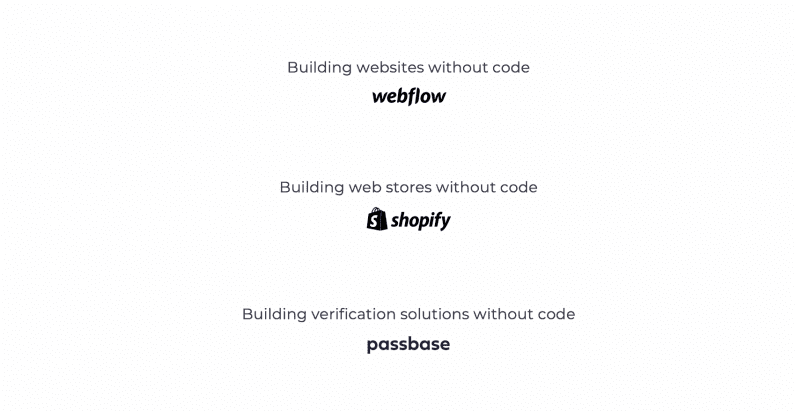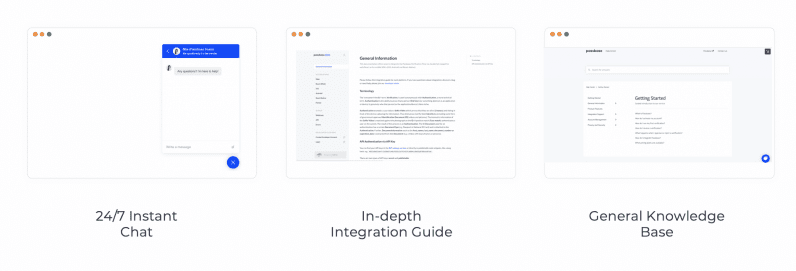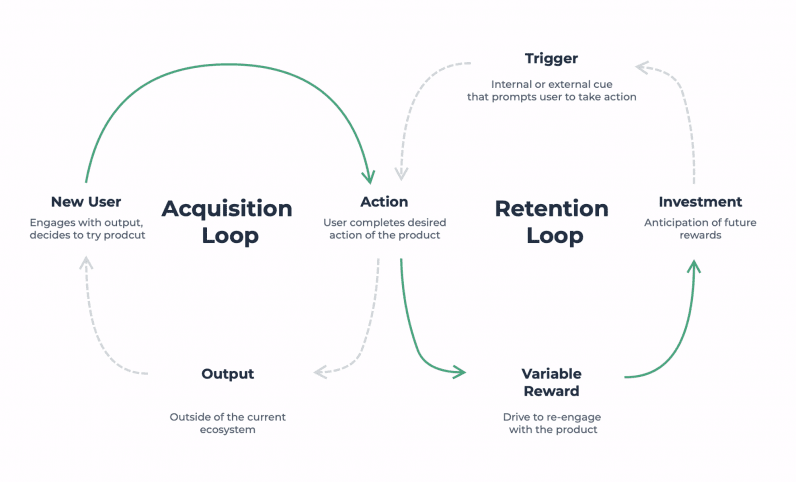The right product execution is the essential instrument to leverage your limited wiggle room as a founder. Especially in a high-paced startup environment with little space for failure, strong execution on the right points can decrease the risk of failure. You might be staring at the wunderkinder in the B2B industry and their unmatched success, but there is a pattern that is repeated in their products and will be undoubtedly implemented by the next wave of brave minds as well.
In this article, I lay down a framework of five pillars, that is also based on how we build and scale products internally at Passbase — a framework that I believe can help you to re-evaluate your perspective of your product efforts and what to focus on next. The framework consists of (I) Solution, (II) Appeal, (III) Trust, (IV) Accessibility and (V) Compound loops. Now let’s dive in.
I. Solution
The most essential piece represents the solution that your product tries to bring to an existing problem. To be totally honest, if your product doesn’t solve a massive pain point in the market with a 10x improvement, you will be doomed to operate at the margins. So don’t look for incremental enhancement opportunities — look for a radical change that sounds too far away for outsiders. Evaluate the existing user journey and the problems with it and aim to bring radical improvements in terms of time and cost by cutting out at least 50% of the steps. As an example, look 10 years back and remember the pain of implementing a payment solution on a website and compare it with the solution of Stripe that reduced the user journey from self-coding, hosting, and partnering with vendors to have a ready-to-go solution that can be implemented with a few simple lines of code. Even more, there’s a new era emerging which goes even further to achieve radical improvement by reducing the friction of even touching code. Look at the user journey again and build untraditional solutions that open the doors to an even bigger audience that can use your solution. Creating value to customers means that they return to your product, tracked by retention rate and churn rate. Don’t look for the amount of downloads or sign ups at the first glance, build a product that has stickiness with continuous value add. I recommend you try to focus on your initial audience and build a product they want — data will help you understand this part. Focus and execute on building the skateboard right before you head down building the whole car. The more often users return and use your product, the more likely they find continuous value in it. If you can retain the majority of your users since they signed up for the first time, you might have found the first magic factor. Ask your customers what they would do if your product would shut down tomorrow — would this break or affect their own product massively? What would be their alternative solution — could your solution be easily replaced? Furthermore, timing is an essential piece of this formula. Imagine how the iPhone in 2007, Android in 2008, or LTE in 2009 gave disruptive opportunities and opened up new market segments. Look around and find new directions that can be leveraged as competitive advantages. Take the time to look at the market opportunity on a meta level and find exponential growth paths in upcoming or even untapped markets that need something that eventually does not exist yet.
II. Appeal
Design can disrupt whole industries by taking usability patterns to a new level. If you look at UBER, that lets you order a cab within two to three clicks, you can see the extent of what happens if you break a current pattern and cut 10 steps out of the user journey towards radical simplicity. Might sound easier said than done, but make your solution as simple as possible, eliminate unnecessary noise and options and focus on the job that needs to be done. Start using the Pareto Principle to find the 20% of actions that reflect 80% of value add. Although, the interesting part of it is, that the majority of users don’t care about the UI or UX — but their subconscious does. The psychology principle known as a visceral reaction states that people decide whether they like something or not within a few seconds of looking at something. This reaction goes faster than our consciousness so we don’t even realize it. By creating a user experience that can disrupt markets and win masses, you have to consider design patterns to build products that people love to use. I summarized this in another blog post 10 essential rules for good product design that can help guide you. Additionally, try to build a brand and a community around your product. Sit down and think what your brand should represent and form a brand identity around it. Invest in the community around your product early on and let them guide you to form an usable initial product. Some of the most successful startups built up one of the strongest tech communities that reflect the need of this initiative. Communities will help to attract the second wave of customers — don’t under-evaluate this piece in the formula.
III. Trust
Trust is essential to win users and to go up market. It will help to increase your conversion rate and give them the proof they want to see. The bigger the clients you go after, the more important this pillar will be. Now to actually build trust, start by looking into your sector and hunt for certificates that prove the quality of your product. Find customers that can help echo your product and brand. Reputation is key — the subconscious of the customer will come into play again. Additionally, re-evaluate and focus on the reliability of your product. A strong infrastructure is essential to serve clients at scale. Robustness of the core product is fundamental before you move into new feature sets. Bring in transparency of your system uptime — a simple status page will help. Another avenue to build trust is to have transparent communication and a world class support team. Split it up into instant support via chat and an in-depth knowledge base to create a support system where customers feel welcome when they seek help.
IV. Accessibility
You need to solve accessibility to accelerate product market fit. Look at every possible dimension of your product to find answers for this pillar. Start with an assessment of your top funnel — can potential users access your product without any hurdles? Or do they have to wait 24 hours until a sales rep picks them up for a demo call the day after? Analyze how potential users find your product. If you’ve underestimated SEO until now, it’s time to focus on next with an extensive content strategy around it. Organic traffic reflects accessibility. Continue your analysis with your landing page: to which audiences in terms of language is it currently available? How does it look like with your product itself? Having no language barriers is undervalued but essential for accessibility. Look at the share of audiences combined with the attractiveness of those markets to strategize your next step. Broaden up your audience by adding new languages — you will be fascinated by the magnitude of your growth numbers. Another dimension includes the product itself. Which integrations do you currently offer to your clients? To which platform is your product compatible with? Bring in the concept of accessible design. There are hundreds of platforms and integrations that help to make your product more accessible and easy to use. Instagram continued their growth by making their platform accessible on the web to enable further scalability and coverage. Look at your customer base and understand on which platforms they operate and how they built their own products. New integrations or partnerships with other platforms can help drive organic leads and result in faster and smoother implementations. Making products accessible can enable new dimensions of scalability. The new stars in the startup universe are cutting out even the sign up step to enable accessibility and interactions. Re-evaluate if and how you could make your core product more accessible without compromising security.
V. Compound loops
Your product won’t hit massive scale if there is no native growth loop implemented. Again, you won’t be able to attract native scale if you can’t bring in organic and free traffic of leads. You need to design a system where every input generates minimum 1.1x more of an output. Those loops are like the compound interest of product growth and can touch different dimensions like new users, returning users, defensibility, or cost effectiveness. There are two dimensions you should build into your product: Acquisition loops and Retention loops.
Acquisition loops are mainly focused on bringing in new users. They help achieve compound growth by focusing on mechanics like viral loops (like referral campaigns like Dropbox’ free space race or PayPal’s famous $20 referral) or user-generated content loops (like Notion’s public pages or Loom’s public videos) that can accelerate the left wheel massively. Let your brain run the exercise of the power of this loop by combining it with pillar (IV) accessibility and you find some answers why Notion or Dropbox generate these massive growth results. Retention loops are in place when engagement at one moment in time leads to more engagement in another. Your product needs to have retention triggers that help users experience its core value to let them return back to the product. There are two dimension, that can help to accelerate the right wheel: Utility-based retention loops (user is invested into the product like uploaded data on Dropbox or literally having a portfolio on Robinhood) and Network-based retention loops (Engagement caused by network, like Slack notifications or email triggers of unread messages on Linkedin). Building up a retention loop means creating stickiness. Use the retention loop to form a habit in your users’ behavior to let them return natively back to your product. Also build a product that has multiple secure acquisition loops. The most powerful loops are organic or through owned channels for increased defensibility. Focus early on building compound loops that will help you to accelerate growth and native retention.
The takeaway
Building a product is easy… but building the right product that can trigger massive growth is hard. Use this framework to re-evaluate your product efforts. It can help spot weaknesses and opportunities that might be the acceleration for adoption and growth. Run this framework as an exercise and grade your product for each pillar from one to five. I guarantee you will notice what to focus on next. The magic kicks in if you fulfill all five pillars with excellence and great execution, and we all might see a new star in the startup sphere.





